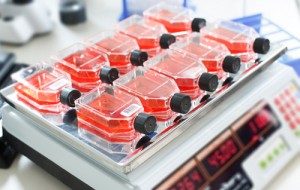 Nuvilex, Inc. plans to develop a diabetes treatment using its Cell-in-a-Box® platform technology. In 2013, the company acquired the exclusive worldwide rights to the cellulose-based-live-cell encapsulation technology usage, becoming well positioned to develop treatments for diabetes. Presently, Nuvilex has advanced in its development of a line of “live cells” that could be encapsulated in the Cell-in-a-Box technology and ultimately used as a bio-artificial pancreas.
Nuvilex, Inc. plans to develop a diabetes treatment using its Cell-in-a-Box® platform technology. In 2013, the company acquired the exclusive worldwide rights to the cellulose-based-live-cell encapsulation technology usage, becoming well positioned to develop treatments for diabetes. Presently, Nuvilex has advanced in its development of a line of “live cells” that could be encapsulated in the Cell-in-a-Box technology and ultimately used as a bio-artificial pancreas.
The company announced that the worldwide rights to use human insulin-producing cells (Melligen cells) were secured. Professor Ann Simpson and her team at the University of Technology in Sydney, Australia (UTS), developed it as a treatment for insulin-dependent diabetes (Type 1 or juvenile-onset).
With these two achievements,Nuvilex has developed both the delivery system and the human insulin-producing cells. With these two developments, the company can compete commercially in the $500 billion diabetes healthcare market. Currently, companies are racing to treat this disease, a truly worrying epidemic condition that affects almost 400 million people. According to the International Diabetes Federation (IDF) data, 552 million patients are expected to have diabetes by 2030.
Type 1 is a form of diabetes characterized by an autoimmune response in which a person’s pancreas ceases producing insulin. Insulin is a hormone that enables the human body to absorb energy from food. The immune system of patients with Type 1 diabetes starts attacking and destroying the insulin-producing cells in the pancreas, known as beta cells. Currently, there is no cure for the disease, and treatment means daily injections of insulin to control blood glucose levels for the rest of the patient’s life.
Dru-Ann Sgarlato of Fredericksburg, Virginia, and close to this disease repercussions since her 12 year-old son is a Type 1 diabetic patient, said when she read that Nuvilex had secured the rights to use these insulin-producing cells: “Amazing! It’s sometimes frustrating that they can do all of this but we still don’t have a cure. Hell, if my son Devin could have 2 years before having to inject these cells again it would be so worth it. I’d cry and fall to my knees,” as quoted from a company press release.
It has been proven through two Phase I/II advanced pancreatic cancer clinical trials that Cell-in-a-Box (a cellulose-based encapsulation technology) continues to function even after long periods of time implanted inside the body; it can last more than 2 years. Also, the technology does not trigger an immune system response.
“We check Devin’s blood sugar approximately 15 times a day and all through the night, every night. At year’s end, Devin’s fingers have been poked no less than 5,400 times,” says Dru-Ann, noting the relevance of a technology that can replace daily insulin injections.
Melligen cells, originally derived from a human liver cancer cell line, have to pass preclinical and clinical tests to be used to replace the insulin-secreting beta cells destroyed in Type 1 diabetics. Nuvilex has to prove that these cells will not form tumors after being implanted.
Nuvilex transplanted islet cells (from pigs) that produce insulin into diabetic rats. Those rats received Cell-in-a-Box with the encapsulated islet cells, and their glucose levels were normalized and remained that way for about 6 months (the study’s duration); also, even in the absence of immunosuppressive drugs, the encapsulated cells were not attacked by immune response.
With these positive results, Nuvilex plans to encapsulate Melligen cells using the Cell-in-a-Box technology and deliver it into Type 1 diabetes patients, hopefully leading to a “bio-artificial pancreas.”


